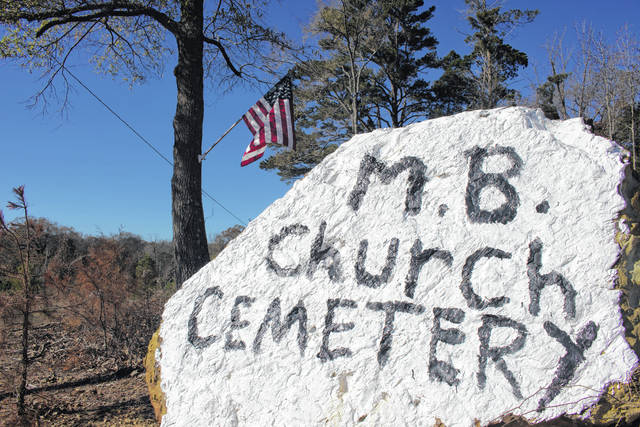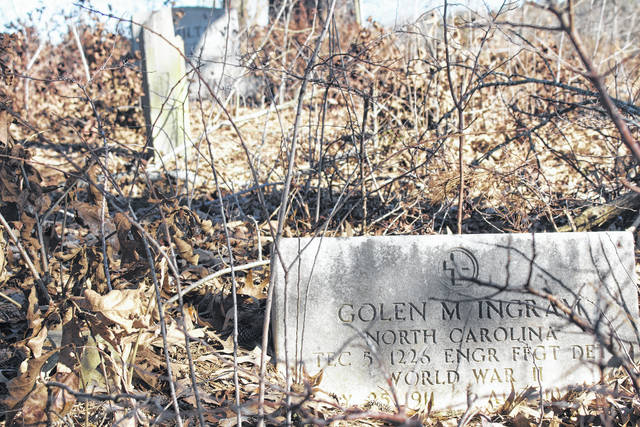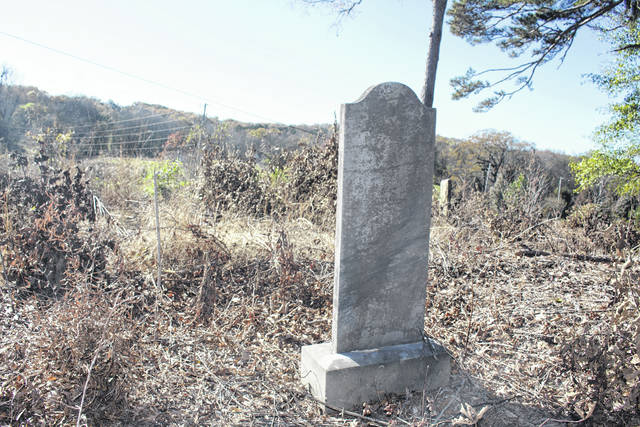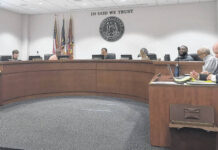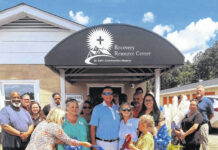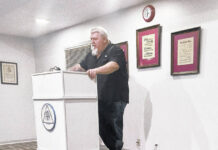
Carol Smith and volunteers gather the names in the cemetery to hopefully connect their living ancestors to their final resting place at the historical Poplar Springs Baptist Church cemetery.
Liz O’Connell | Anson Record
BURNSVILLE — Memories of filing into a local church with her family brought Carol Smith to finally fill a missing piece of her family’s history, and she hopes to give other local families their own piece of history.
Smith remembers her church goings as a little girl, but she had vague memories of the little hilltop cemetery associated with Poplar Springs Baptist Church in Burnsville.
She knew her great-grandmother was laid to rest at this site, but since the late-1950s, the cemetery remained dormant.
As the years went on, the 19th century cemetery passed from owner to owner and a place for family members to visit their loved ones was transformed into an overgrown plot of land, leaving forgotten family members behind and Smith unable to find her great-grandmothers stone.
“I grew up knowing about the cemetery and knowing a little bit about some of the history,” Smith said. “It has just become an eyesore to a lot of people. A lot of people didn’t even know it existed.”
Smith first began this restoration project in the beginning of 2020 by clearing out the three-mile area with the help of a group of women that collect information on grave markers, known as grave hunters.
“This will hopefully give ancestors an opportunity to see where their loved ones are buried,” Smith said.
Together Smith and her volunteers ventured to the hilltop cemetery to take photos of the grave markers. The women helping Smith have since drafted a book with the names of those buried in this abandoned hilltop. The book includes the individual names, death certificates, who signed off on the death certificate and pictures of the recovered stones.
“We found 167 different people that were buried at that particular location and this is not all of them,” Smith said. “They were buried there and they have been forgotten.”
An intern from Wingate University also joined the project, helping collect historical data and giving the living ancestors a piece of their family’s history.
But many of the graves do not have readable markers. Some are just large pieces of rock or stone with no writings.
While going through the cemetery and working on this project, Smith always felt this was a way to connect herself back to her family. Her 91-year-old mother remembers going to the cemetery, but Smith wanted to know more than passed-on stories.
Smith felt a sense of herself buried beneath her feet while gathering information on the hilltop. Her great-grandmother, great-grandfather and great-uncle, who served in the military, are all buried at this cemetery.
She still does not know where her great-grandfather and great-uncle are buried. Smith believes previous owners created large piles of dirt and she is unsure if there are more grave markers under all those piles.
But her young great-grandmother’s stone still stands.
Smith choked up talking about finding her great-grandmother, taking a minute to collect her emotions.
“When I saw that, just a moment came over me, my physical body,” Smith calmly said. “It was like an energy…a form of energy like goosebumps or something like that. It brings an emotional response.”
The land up on the hill first became a cemetery when the late Jasper Turner of Anson County received the donated property. He buried his family on the portion of the land, according to Smith.
She said at one point, the cemetery was owned by a slave owner. He decided to give his slaves a proper burial and buried them in one section of the cemetery, while the “free” people were buried in another section.
“At the time, the cemetery was on level ground,” Smith said. “Now it’s not because business owners from out of this area came in and wanted to create a dirt track for fun and for young people to ride. They cleared out a lot of the land, a lot of the property around that cemetery.”
The owners who created the dirt track dug out a path around this hilltop cemetery about 10 to 15 years ago, according to Smith.
“When they bought the land, the cemetery was abandoned at that time because a lot of the older people that was part of Poplar Springs Church has stopped burying there and they were burying at a place near the church,” Smith said. “This particular old cemetery they had just forgotten.”
As you pull up to the property, you pass by what looks like an abandoned building and then to your right you see a dirt bike track. Straight ahead there are two American flags hanging off trees and a large painted rock signaling the start of the cemetery.
These additions are part of the restoration. It helps define this historic plot of land.
The rest of the land is covered in crunchy fallen leaves, shrubbery and overgrown trees.
With the grave hunters help, Smith has been able to get a site number through the North Carolina Office of State Archaeology. This site number verifies the land is now a historical cemetery and no one can remove, demolish or break the stones.
“Where we are now, we’ve gotten the site number, we’ve gotten larger trees cut and moved off of the property so we can get in there,” Smith said. “We’ve been able to have a young man by the name of Nick Gaddy with his company that sprays and kills brushes and stuff like that.”
The next step now that the brush and overgrown plants are dying is to clear out the rest of the land.
The Burnsville Recreation and Learning Center will be hosting a series of clean-up events to restore this now historic Anson landmark. Starting at 9 a.m. on Dec. 5, volunteers can come out and help clearing out the brush and trees little by little.
Volunteers are asked to bring tools such as wheel barrels, racks, axes, hedge clippers and more. There will be a lunch provided to those who participate.
“We are trying to bring some things together, hopefully, through help from the community…to create a memorial place that community, families and all will be able to go and remember,” Smith said.
Smith is working with Poplar Springs Baptist Church to ensure this cemetery continues to be looked after. She hopes this project will be placed in the church’s instructions to clean the land every quarter so it is never overgrown again.
Reach Liz O’Connell at 267-467-5613 or at eoconnell@ansonrecord.com. Follow on Twitter at @TheAnsonRecord.

